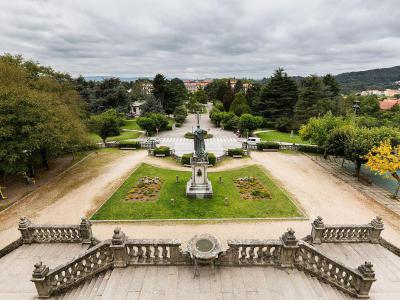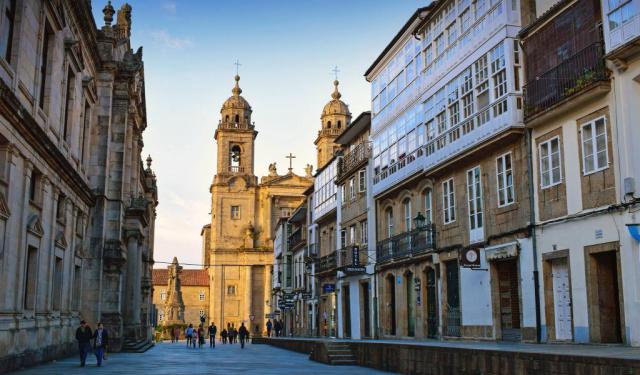Parque La Alameda (Alameda Park), Santiago de Compostela
Alameda Park is a prominent urban park that holds great significance for both locals and tourists. Comprising three distinct areas, namely the Paseo da Alameda, the Carballeira de Santa Susana, and the Paseo da Ferradura or Paseo dos Leóns, the park has become a notable architectural and botanical landmark.
At the heart of the park lies the Paseo da Alameda, featuring a central promenade divided into three corridors that were originally designed for different social classes during the 19th century. The Paseo dos Leóns, accessible through a triumphal arch house, is adorned with flower beds, fountains, ponds, statues, and sculptures. Along the Paseo da Ferradura, visitors can admire a diverse range of ornamental tree species, such as oaks, eucalyptus trees, and horse chestnut trees.
The park reflects the passage of time through its spatial arrangement and architectural structures. It houses significant buildings including the Church of El Pilar, the Pavilion of Artistic and Industrial Recreation (the sole remaining structure from the Galician Regional Exhibition of 1909), a dovecote, a music kiosk, and an acoustic bench. Additionally, the park is known for its granite benches with artistic backings, crafted by the renowned Sargadelos factory, which contribute to its aesthetic appeal.
The Carballeira de Santa Susana, a magnificent oak grove, encircles a church built in the 12th century to accommodate the relics of Santa Susana. The park's origins date back to 1546 when Rodrigo de Moscoso Osorio y Álvarez de Toledo, the IV Count of Altamira, generously donated agricultural land for the enjoyment of the people of Santiago. In 1835, the Campo da Estrela and the Paseo da Ferradura were established, encircling the Carballeira de Santa Susana. The Paseo de los Leones, named after two lion-shaped sculptures relocated from Porta Faxeira, has gained renown as a remarkable section of the park.
With an expansive area of 56,087 square meters, Alameda Park boasts gentle slopes and stands out for its botanical and monumental significance. It offers numerous viewpoints from which visitors can admire the old city and enjoy panoramic vistas of Mount Pedroso, the Residence (Campus Sur or Campus Vida), and the southern outskirts of Santiago.
The park provides ample shaded areas, spacious lawns, and rest zones with comfortable benches. Clear signage guides pedestrians, and cycling is permitted within the park. It is also designed to be accessible for individuals with physical disabilities, offering amenities such as drinking water fountains, ponds, a children's playground, public restrooms, night lighting, an information point, and nearby parking areas (subject to fees). Alameda Park truly captures the essence of natural beauty and tranquility in Santiago de Compostela.
At the heart of the park lies the Paseo da Alameda, featuring a central promenade divided into three corridors that were originally designed for different social classes during the 19th century. The Paseo dos Leóns, accessible through a triumphal arch house, is adorned with flower beds, fountains, ponds, statues, and sculptures. Along the Paseo da Ferradura, visitors can admire a diverse range of ornamental tree species, such as oaks, eucalyptus trees, and horse chestnut trees.
The park reflects the passage of time through its spatial arrangement and architectural structures. It houses significant buildings including the Church of El Pilar, the Pavilion of Artistic and Industrial Recreation (the sole remaining structure from the Galician Regional Exhibition of 1909), a dovecote, a music kiosk, and an acoustic bench. Additionally, the park is known for its granite benches with artistic backings, crafted by the renowned Sargadelos factory, which contribute to its aesthetic appeal.
The Carballeira de Santa Susana, a magnificent oak grove, encircles a church built in the 12th century to accommodate the relics of Santa Susana. The park's origins date back to 1546 when Rodrigo de Moscoso Osorio y Álvarez de Toledo, the IV Count of Altamira, generously donated agricultural land for the enjoyment of the people of Santiago. In 1835, the Campo da Estrela and the Paseo da Ferradura were established, encircling the Carballeira de Santa Susana. The Paseo de los Leones, named after two lion-shaped sculptures relocated from Porta Faxeira, has gained renown as a remarkable section of the park.
With an expansive area of 56,087 square meters, Alameda Park boasts gentle slopes and stands out for its botanical and monumental significance. It offers numerous viewpoints from which visitors can admire the old city and enjoy panoramic vistas of Mount Pedroso, the Residence (Campus Sur or Campus Vida), and the southern outskirts of Santiago.
The park provides ample shaded areas, spacious lawns, and rest zones with comfortable benches. Clear signage guides pedestrians, and cycling is permitted within the park. It is also designed to be accessible for individuals with physical disabilities, offering amenities such as drinking water fountains, ponds, a children's playground, public restrooms, night lighting, an information point, and nearby parking areas (subject to fees). Alameda Park truly captures the essence of natural beauty and tranquility in Santiago de Compostela.
Want to visit this sight? Check out these Self-Guided Walking Tours in Santiago de Compostela. Alternatively, you can download the mobile app "GPSmyCity: Walks in 1K+ Cities" from Apple App Store or Google Play Store. The app turns your mobile device to a personal tour guide and it works offline, so no data plan is needed when traveling abroad.
Parque La Alameda (Alameda Park) on Map
Sight Name: Parque La Alameda (Alameda Park)
Sight Location: Santiago de Compostela, Spain (See walking tours in Santiago de Compostela)
Sight Type: Attraction/Landmark
Guide(s) Containing This Sight:
Sight Location: Santiago de Compostela, Spain (See walking tours in Santiago de Compostela)
Sight Type: Attraction/Landmark
Guide(s) Containing This Sight:
Walking Tours in Santiago de Compostela, Spain
Create Your Own Walk in Santiago de Compostela
Creating your own self-guided walk in Santiago de Compostela is easy and fun. Choose the city attractions that you want to see and a walk route map will be created just for you. You can even set your hotel as the start point of the walk.
Santiago de Compostela Introduction Walking Tour
Legend has it that after Saint James, one of the Twelve Apostles of Jesus, was martyred in Jerusalem in 44 AD, his followers carried his decapitated body by sea to Spain. Others claim that the saintly remains were miraculously taken up by angels and sailed to the coast of Galicia, where a massive rock closed around it and was later moved to its final resting place.
Either way, during the... view more
Tour Duration: 2 Hour(s)
Travel Distance: 1.7 Km or 1.1 Miles
Either way, during the... view more
Tour Duration: 2 Hour(s)
Travel Distance: 1.7 Km or 1.1 Miles




